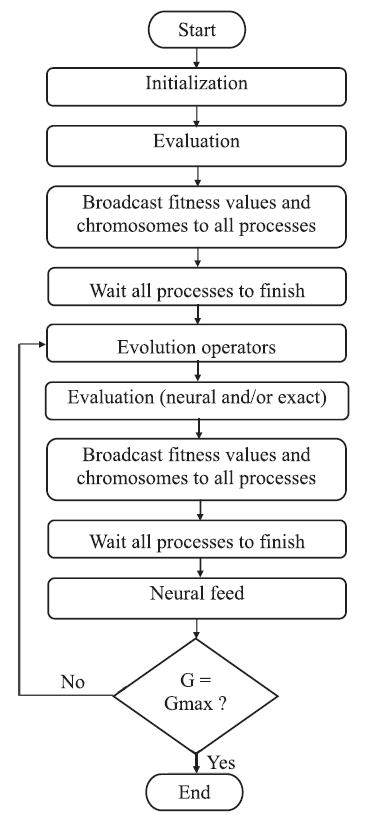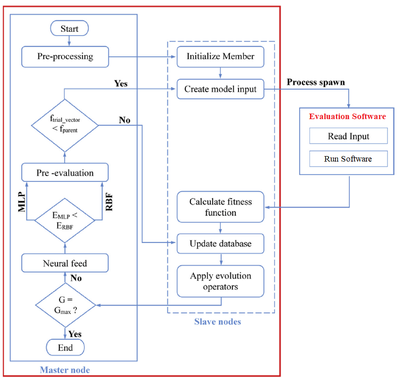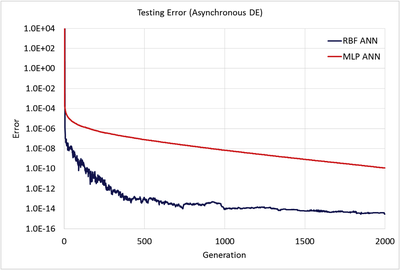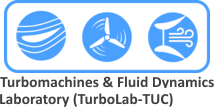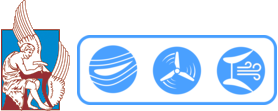ASPIDES (Asynchronous/Synchronous Parallel Intelligent Differential Evolution Software):
ASPIDES is a design optimization software, which incorporates a parallel (synchronous or asynchronous) metamodel-assisted Differential Evolution (DE) algorithm, developed in Fortran by members of the Turbomachines & Fluid Dynamics Laboratory (TurboLab-TUC). It uses a unique population that is distributed among the processors/cores, with a Master-Slave architecture. Separate executables can be used to perform the evaluation of each individual (candidate solution) in the population, while the required data exchange and communication between the processors is achieved using MPI (Message Passing Interface) library functions. Furthermore, the utilization of two Artificial Neural Networks (ANNs) as surrogate models within the ASPIDES enhances its performance by substituting the computationally time-consuming exact evaluations of the fitness function with low-cost approximations.
DE is a versatile stochastic search method, introduced by Storn and Price, capable of handling non-differentiable, nonlinear and multimodal cost functions, providing superior convergence performance than other Evolutionary Algorithms (EAs). Contrary to other EAs, the DE compares each new candidate member (offspring) of the population only against a single existing one (parent). This characteristic renders DE suitable for asynchronous parallel applications. The new parameter vector (offspring) results after applying mutation and crossover operators.
The concept of utilizing surrogate models inside ASPIDES (in the evaluation procedure) is to replace the costly exact evaluations with fast inexact approximations, without sacrificing the robustness of the software. These surrogate models are established using a data-driven approach, where only the input and output data of the cost function are taken into account, as to create a mechanism that mimics its behavior. Two types of Artificial Neural Networks (ANNs) are used as surrogate models; a Multi-layer Perceptron (MLP) and a Radial Basis Function (RBF) ANN, respectively. The utilized surrogate models can be used either independently or as an ensemble. In the first case, a single surrogate is used throughout the whole optimization procedure. In the second case all surrogates are re-trained and re-tested in each generation. Then, only the best one is used in the pre-evaluation phase of the trial vectors.
The concept behind the developed parallelization strategy is to enable the cooperation of the ASPIDES with different simulation software in the form of executables. The required data transfer between the ASPIDES and the simulation software is succeeded with appropriate text files. The communication among the processors and the parallel implementation is achieved using Message Passing Interface (MPI) library functions. The proposed strategy appears to be quite efficient, regardless of the use of text files, considering that the computational time of data transfer is negligible compared to that of the evaluation step. Two different parallel implementations have been developed, a synchronous and an asynchronous one.
References:
I.K. Nikolos, "Inverse Design of Aerodynamic Shapes using Differential Evolution coupled with Artificial Neural Network", Proceedings of the ERCOFTAC Conference in Design Optimization: Methods and Applications, Athens, Mar. 31- Apr. 2, 2004.
E.S. Zografos, I.K. Nikolos, "Design Optimization of Aerodynamic Shapes Using Differential Evolution", Proceedings of the 7th National Congress on Mechanics, pp. 339-344, June 24-26, 2004, Chania, Greece.
I.K. Nikolos, "Chapter 8: Surrogate modeling in evolutionary based engineering design optimization", in Y. Tsompanakis, B.H.V. Topping (Eds.), Soft Computing Methods for Civil and Structural Engineering, Computational Science, Engineering and Technology Series: 29, Saxe-Coburg Publications, pp. 173-203, 2011.
I.K. Nikolos, "On the use of multiple surrogates within a differential evolution procedure for high-lift airfoil design", International Journal of Advanced Intelligence Paradigms, 5(4), pp. 319-341, 2013. DOI:10.1504/IJAIP.2013.058302
S.N. Leloudas, G.A. Strofylas, I.K. Nikolos, "Airfoil optimization using area-preserving free-form deformation", Proceedings of the ASME 2015 International Mechanical Engineering Conference & Exposition, IMECE2015, Nov. 13-19, Houston, Texas, USA, Paper No. IMECE2015-50904. https://doi.org/10.1115/IMECE2015-50904
G.A. Strofylas, I.K. Nikolos, "Reverse Engineering of a Wind Turbine Blade Surface using Differential Evolution", in Y. Tsompanakis, J. Kruis, B.H.V. Topping, (Editors), Proceedings of the Fourth International Conference on Soft Computing Technology in Civil, Structural and Environmental Engineering, Civil-Comp Press, Stirlingshire, UK, Paper 7, 2015. doi:10.4203/ccp.109.7
K.N. Porfyri, I.K. Nikolos, A.I. Delis, M. Papageorgiou, "Calibration of a second-order traffic flow model using a metamodel-assisted Differential Evolution algorithm", Proceedings of the 19th IEEE Intelligent Transportation Systems Conference, ITSC'16, Rio de Janeiro, Brazil, November 1-4, 2016. DOI: 10.1109/ITSC.2016.7795581
K.N. Porfyri, A.I. Delis, I.K. Nikolos, M. Papageorgiou, "Calibration and validation of a macroscopic multi-lane traffic flow model using a differential evolution algorithm", Proceedings of the Transportation Research Board 96th Annual Meeting, Washington, D.C., January 8-12, 2017 (17-01340).
G.A. Strofylas, K.N. Porfyri, I.K. Nikolos, A.I. Delis, M. Papageorgiou, "Calibrating a Traffic Flow Model with Parallel Differential Evolution", in P. Iványi, B.H.V. Topping, G. Várady, (Editors), Proceedings of the Fifth International Conference on Parallel, Distributed, Grid and Cloud Computing for Engineering, Civil-Comp Press, Stirlingshire, UK, Paper 26, 2017. doi:10.4203/ccp.111.26
G.A. Strofylas, K.N. Porfyri, I.K. Nikolos, A.I. Delis, M. Papageorgiou, “Using Synchronous and Asynchronous Parallel Differential Evolution for Calibrating a Second-order Traffic Flow Model”, Advances in Engineering Software, 125, pp. 1-18, 2018. https://doi.org/10.1016/j.advengsoft.2018.08.011
S.N. Leloudas, G.A. Strofylas, I.K. Nikolos, "Aerodynamic shape optimization of Diffuser Augmented Wind Turbine blades using asynchronous parallel Differential Evolution", Proceedings of the 9th GRACM International Congress on Computational Mechanics, Chania, 4-6 June, 2018.
S.N. Leloudas, G.A. Strofylas, I.K. Nikolos, "Constrained Airfoil Optimization Using the Area-Preserving Free-Form Deformation", Aircraft Engineering and Aerospace Technology, 90(6), pp. 914-926, 2018. https://doi.org/10.1108/AEAT-10-2016-0184
S.N. Leloudas, G.N. Lygidakis, G.A. Strofylas, I.K. Nikolos, "Aerodynamic Shape Optimization of Diffuser Augmented Wind Turbine Shrouds Using Asynchronous Differential Evolution", Proceedings of the ASME International Mechanical Engineering Congress and Exposition, IMECE 2018, 9-15 November, 2018, Pittsburgh, PA, USA, Paper No. IMECE2018-86820. https://doi.org/10.1115/IMECE2018-86820
K. Porfyri, Traffic flow modeling in the presence of Vehicle Automation and Communication Systems, Ph.D. Thesis, School of Production Engineering & Management, Technical University of Crete, 18/7/2019.
G.A. Strofylas, Development of computational tools, based on Radial Basis Functions and Differential Evolution, for the parametric design of aeroelastic systems, Ph.D. Thesis, School of Production Engineering & Management, Technical University of Crete, 26/4/2021.
V. Pissas, Contribution in the acceleration of a parallel asynchronous Differential Evolution algorithm using Artificial Neural Networks, M.Sc. Thesis, School of Production Engineering & Management, Technical University of Crete, 8/10/2021.
Numerical Applications and Simulations
